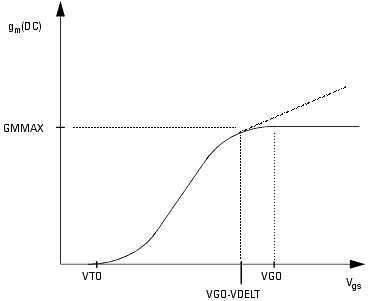Print version of this Book (PDF file)
Drain-Source Current
The drain-source current model in Agilent EEFET3 is comprised of various analytic expressions that were developed through examination of gm vs. bias plots on a wide class of devices from various manufacturers. The expressions below are given for Vds > 0.0 V although the model is equally valid for Vds < 0.0 V. The model assumes the device is symmetrical, and one need only replace Vgs with Vgd and Vds with -Vds in order to obtain the reverse region (Vds < 0.0 V) equations. The gm, gds and Ids equations take on 4 different forms depending on the value of Vgs relative to some of the model parameters. The Ids expression is continuous through at least the second derivative everywhere.
else if VDELT > 0.0 and Vgs > Vgb
The preceding relations for Idso, gmo and gdso can now be substituted in the following equations that model the current saturation and output conductance. This portion of the model can be recognized from the work of Curtice [1].
These expressions do an excellent job of fitting GaAs FET I-V characteristics in regions of low power dissipation; they will also fit pulsed (isothermal) I-V characteristics. To model negative conductance effects due to self-heating, the thermal model of Canfield was incorporated [2]. With this final enhancement, the DC expressions for Ids and associated conductances become:
Qualitatively, the operation of the drain-source model can be described as follows:
The Vds dependence of the equations is dominated by the parameters VSAT, GAMMA, KAPA, and PEFF. Isothermal output conductance is controlled by GAMMA and KAPA. The impact of GAMMA on output conductance is more significant near threshold. At Vgs=VCH, the output conductance is controlled only by KAPA. The parameter PEFF provides a correction to the isothermal model for modeling the self-heating effects manifested as a negative resistance on the I-V curves. The parameter VSAT represents the drain-source voltage at which the current saturates and output conductance becomes a constant (approximately).
The overall impact of VCH on the I-V characteristics is second order at best, and many different values of VCH will provide good fits to I-V plots. For most applications encountered, it is our experience that the default value of 1.0V is an adequate value for VCH. Similar to VCH, VDSO is a parameter that should be set rather than optimized. At Vds=VDSO, the drain-source model collapses to a single voltage dependency in Vgs. It is recommended that the user set VDSO to a typical Vds operating point in saturation. At this point, many of the parameters can be extracted right off a Ids-Vgs plot for Vds=VDSO or preferably, a gm(DC)-Vgs plot at Vds=VDSO.
When Vds=VDSO and PEFF is set large (to disable the self-heating model), the significance of the parameters VTO, VGO, VDELT, GMMAX are easily understood from a plot of gm(DC)-Vgs. GMMAX is the peak constant transconductance of the model that occurs at Vgs=VGO. The parameter VTO represents the gate-source voltage where gm goes to zero. If VDELT is set to a positive value, then it causes the transconductance to become linear at Vgs = VGO - VDELT with a slope equal to that of the underlying cosine function at this voltage. The parameter definitions are illustrated in the following figure.
 Vg and VDELT
Vg and VDELT  0.0
0.0
















